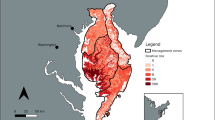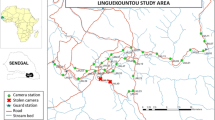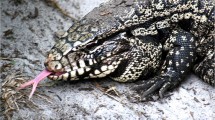Abstract
Confirming eradication success can be notoriously difficult and costly, especially when the species is still present but remains undetected, due to very low population densities and imperfect detection methods. There has been a lack of research on appropriate guidelines and estimation procedures for declaring eradication success for programs aimed at eradicating alien reptiles. Here we develop quantitative rules for confirmation monitoring in eradication campaigns of the red-eared slider turtle (Trachemys scripta elegans). We used a database of slider trapping data from control and eradication campaigns conducted in localities across the Iberian Peninsula and southern France to construct models for inferring appropriate trapping efforts for confirming slider turtle eradication. Basking traps were slightly more efficient than net traps in capturing sliders, although trapping was an inefficient monitoring method given the low capture probabilities estimated. The results of our spatially-explicit eradication scenarios revealed the importance of habitat configuration in declaring eradication success. Declaration of eradication success is contingent on the thresholds set to minimise false positives (i.e., falsely declaring eradication successful), but in any scenario large trapping efforts were required to confirm eradication. Given the low estimated capture probabilities, alternative methods such as eDNA and visual surveys should be considered for monitoring sliders. We suggest that if the costs associated with the impact of alien sliders can be adequately estimated, then eradication can be confirmed by rules minimising both false positive and negative error rates. Otherwise, rules minimising false positive errors would be more appropriate.




Similar content being viewed by others
References
Anderson D, Ramsey D, Nugent G (2013) A novel approach to assess the probability of disease eradication from a wild-animal reservoir host. Epidemiol Infect 141:1509–1521
Bluett RD, Cosentino BJ (2013) Estimating occupancy of Trachemys scripta and Chrysemys picta with time-lapse cameras and basking rafts: a pilot study in Illinois, USA. Illinois State Academy of Science. Transactions 106:15–21
Burgman MA, McCarthy MA, Robinson A et al (2013) Improving decisions for invasive species management: reformulation and extensions of the Panetta-Lawes eradication graph. Divers Distrib 19:603–607
Davy CM, Kidd AG, Wilson CC (2015) Development and validation of environmental DNA (eDNA) markers for detection of freshwater turtles. PLoS ONE 10:e0130965
Epanchin-Niell RS, Haight RG, Berec L et al (2012) Optimal surveillance and eradication of invasive species in heterogeneous landscapes. Ecol Lett 15:803–812
Ficetola F, Rodder D, Padoa-Schioppa E (2012) Trachemys scripta (slider terrapin). In: Francis R (ed) A handbook of global freshwater invasive species. Earthscan, Oxon, pp 331–339
Franch M, Llorente GA, Montori A (2007) Primeros datos sobre la biología de Trachemys scripta elegans en sintopía con Mauremys leprosa en el Delta del Llobregat (NE Ibérico). In: GEIB Grupo Especialista en Invasiones Biológicas (ed) Invasiones Biológicas: un factor de cambio global. GEIB Grupo Especialista en Invasiones Biológicas, León, Spain, pp 85–101
García-Díaz P, Ross JV, Ayres C et al (2015) Understanding the biological invasion risk posed by the global wildlife trade: propagule pressure drives the introduction and establishment of Nearctic turtles. Glob Change Biol 21:1078–1091
García-Díaz P, Ross JV, Woolnough AP et al (2016) The illegal wildlife trade is a likely source of alien species. Conserv Lett. doi:10.1111/conl.12301
Gelman A, Meng X-L, Stern H (1996) Posterior predictive assessment of model fitness via realized discrepancies. Stat Sin 6:733–760
Groves CR, Game ET (2016) Conservation planning: informed decisions for a healthier planet. Roberts, Greenwood Village
Guillera-Arroita G, Hauser CE, McCarthy MA (2014) Optimal surveillance strategy for invasive species management when surveys stop after detection. Ecol Evol 4:1751–1760
Héritier L, Valdeón A, Sadaoui A et al (2017) Introduction and invasion of the red-eared slider and its parasites in freshwater ecosystems of southern Europe: risk assessment for the European pond turtle in wild environments. Biodivers Conserv 1–27. doi:10.1007/s10531-017-1331-y
Hoffmann BD, Luque GM, Bellard C et al (2016) Improving invasive ant eradication as a conservation tool: a review. Biol Conserv 198:37–49
Iglesias R, García-Estévez JM, Ayres C et al (2015) First reported outbreak of severe spirorchiidiasis in Emys orbicularis, probably resulting from a parasite spillover event. Dis Aquat Organ 113:75–80
Jones HP, Holmes ND, Butchart SHM et al (2016) Invasive mammal eradication on islands results in substantial conservation gains. PNAS 113:4033–4038
Kraus F (2009) Alien reptiles and amphibians: a scientific compendium and analysis. Springer, Dordrecht
Kraus F (2015) Impacts from invasive reptiles and amphibians. Annu Rev Ecol Evol Syst 46:75–97
Lasceve M (2014) Premiers résultats de l’opération de limitation de la population de tortues de Floride sur le site des Vieux Salins, Hyères (Var, France) Scientific Reports of Port-Cros National Park, vol 28, pp 195–201
Lebboroni M, Cecchini A (2005) Basking counts as abundance indices in pond populations of Emys orbicularis. Herpetol J 15:121–124
Lindenmayer DB, Likens GE (2009) Adaptive monitoring: a new paradigm for long-term research and monitoring. Trends Ecol Evol 24:482–486
McIntosh CR, Finnoff DC, Settle C et al (2009) Economic valuation and invasive species. In: Keller RP, Lodge DM, Lewis MA, Shogren JF (eds) Bioeconomics of invasive species. Integrating ecology, economics, policy, and management. Oxford University Press, New York, pp 151–179
O’Keeffe S (2009) The practicalities of eradicating red-eared slider turtles (Trachemys scripta elegans). Aliens Invas Species Bull 28:19–25
Pearson SH, Avery HW, Spotila JR (2015) Juvenile invasive red-eared slider turtles negatively impact the growth of native turtles: implications for global freshwater turtle populations. Biol Conserv 186:115–121
Pérez-Santigosa N, Díaz-Paniagua C, Hidalgo-Vila J et al (2006a) Características de dos poblaciones reproductoras del galápago de Florida, Trachemys scripta elegans, en el suroeste de España. Rev Esp Herpetol 20:5–16
Pérez-Santigosa NP, Paniagua CD, Vila JH et al (2006b) Trampas y plataformas de asoleamiento: la mejor combinación para erradicar galápagos exóticos. Bol Asoc Herpetol Esp 17:115–120
Plummer M (2003) JAGS: a program for analysis of Bayesian graphical models using Gibbs sampling. In: Proceedings of the 3rd international workshop on distributed statistical computing (DSC 2003), Vienna, Austria, pp 20–22
Possingham HP, Franklin J, Wilson K et al (2005) The roles of spatial heterogeneity and ecological processes in conservation planning. In: Lovett GM, Turner MG, Jones CG, Weathers KC (eds) Ecosystem function in heterogeneous landscapes. Springer, New York, pp 389–406
R Development Core Team (2015) R: A language and environment for statistical computing. R Foundation for Statistical Computing, Vienna
Ramsey DS, Parkes J, Morrison SA (2009) Quantifying eradication success: the removal of feral pigs from Santa Cruz Island, California. Conserv Biol 23:449–459
Ramsey DS, Parkes JP, Will D et al (2011) Quantifying the success of feral cat eradication, San Nicolas Island, California. New Zeal J Ecol 35:163–173
Regan HM, Ben-Haim Y, Langford B et al (2005) Robust decision-making under severe uncertainty for conservation management. Ecol Appl 15:1471–1477
Regan TJ, McCarthy MA, Baxter PWJ et al (2006) Optimal eradication: when to stop looking for an invasive plant. Ecol Lett 9:759–766
Rout TM, Kirkwood R, Sutherland DR et al (2014) When to declare successful eradication of an invasive predator? Anim Conserv 17:125–132
Russell JC, Binnie HR, Oh J et al (2016) Optimizing confirmation of invasive species eradication with rapid eradication assessment. J Appl Ecol 54:160–169
Sancho V, Lacomba JI (2016) Expansion of Trachemys scripta in the Valencian Community (Eastern Spain). Proc Int Symp Fresh Turtles Conserv 1:41–49
Seebens H, Blackburn TM, Dyer EE et al (2017) No saturation in the accumulation of alien species worldwide. Nat Commun 8:14435
Spiegelhalter DJ, Best NG, Carlin BP et al (2002) Bayesian measures of model complexity and fit. J R Stat Soc Ser B (Statistical Methodology) 64:583–639
Tobin P, Kean J, Suckling D et al (2014) Determinants of successful arthropod eradication programs. Biol Invas 16:401–414
Valdeón A, Crespo-Diaz A, Egaña-Callejo A et al (2010) Update of the pond slider Trachemys scripta (Schoepff, 1792) records in Navarre (Northern Spain), and presentation of the Aranzadi Turtle Trap for its population control. Aquat Invas 5:297–302
Ward DF, Anderson DP, Barron MC (2016) Using spatially explicit surveillance models to provide confidence in the eradication of an invasive ant. Sci Rep 6:34953
Will DJ, Campbell KJ, Holmes ND (2015) Using digital data collection tools to improve overall cost-efficiency and provide timely analysis for decision making during invasive species eradication campaigns. Wildl Res 41:499–509
Acknowledgements
This research was conducted thanks to the Department of Economic Development, Jobs, Transport and Resources Invasive Plants and Animals Research Project When to stop: Defining rules for surveillance of red-eared slider turtles (Victoria State Government, Australia). We want to thank C. Ayres, J.V. Ross, A. Rodríguez-Pereira, P. Cassey, N. Ainsworth, two anonymous reviewers, and the editor for their comments, support and help. The slider trapping campaigns were possible thanks to the funding, help and support provided by many institutions and people. Full acknowledgments are available in Online Resource 1.
Author information
Authors and Affiliations
Corresponding author
Electronic supplementary material
Below is the link to the electronic supplementary material.
Rights and permissions
About this article
Cite this article
García-Díaz, P., Ramsey, D.S.L., Woolnough, A.P. et al. Challenges in confirming eradication success of invasive red-eared sliders. Biol Invasions 19, 2739–2750 (2017). https://doi.org/10.1007/s10530-017-1480-7
Received:
Accepted:
Published:
Issue Date:
DOI: https://doi.org/10.1007/s10530-017-1480-7




